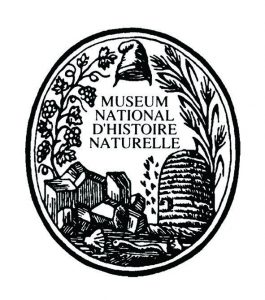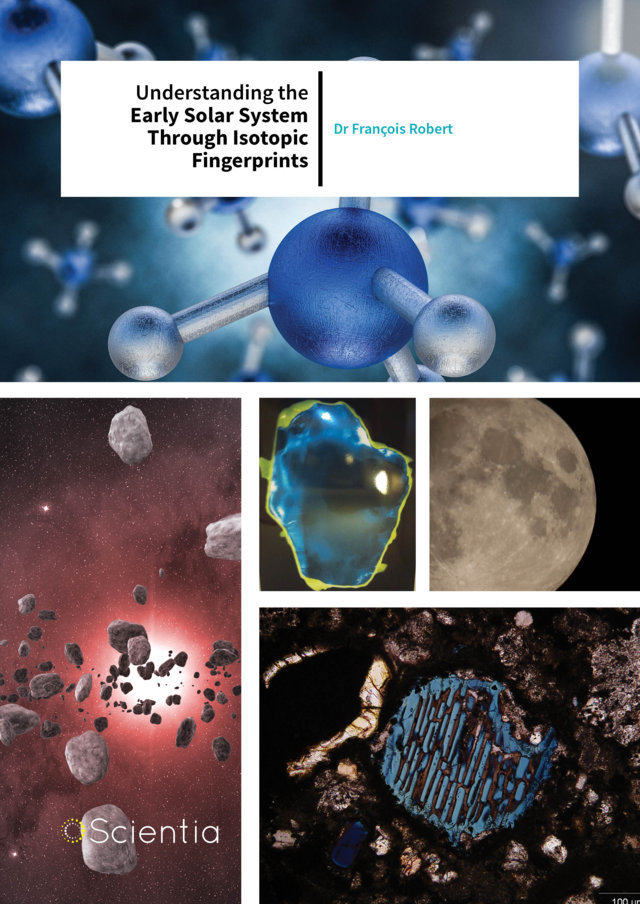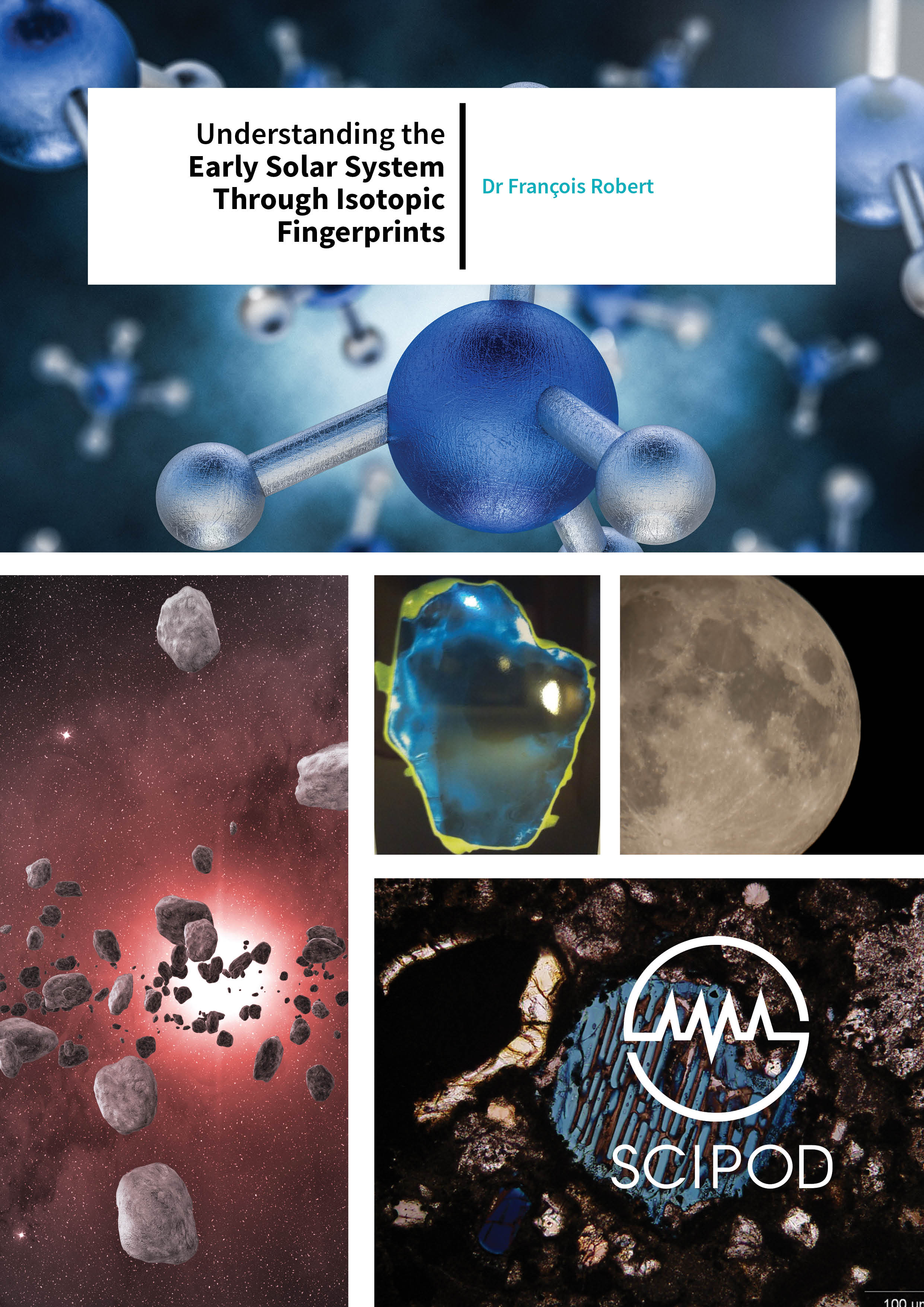Dr François Robert – Understanding the Early Solar System Through Isotopic Fingerprints
During the early stages of the solar system formation, the development of molecular organic and inorganic structures occurred through poorly documented mechanisms such as photochemistry or nuclear reactions. Directly probing such phenomena in the laboratory is almost impossible. However, isotopic compositions in lunar soils or in meteorites are chemical fingerprints, which Dr François Robert at the National Museum of Natural History, France, uses to resolve these unexplained phenomena.
In the fields of geochemistry and cosmochemistry, the study of isotopic composition is used to understand fundamental formation processes of geo- and cosmo-materials. Each element can exist as several stable and unstable isotopes – with each isotope having a different mass. Isotopes of a particular element retain their atomic identity by possessing the same number of protons and electrons, but differ in the number of neutrons they hold in the nucleus. The electronic configurations of different isotopes of the same atom are thus identical, while the total mass of each atom, due to varying numbers of neutrons, is different. Therefore, the mechanisms responsible for variations in the relative abundance of each isotope are restricted to a small number of processes – hence their applicability in reconstructing past natural environments.
During the Sun’s formation, a protosolar disk – a disk of high-density gas and grains – surrounds a dense core. These grains are composed of minerals now found within meteorites which retain the isotopic proportions that were present during their initial formation. Thus, meteorites are regarded as chemical archives of processes that governed the creation of the Sun and our solar system.
Dr François Robert has focused his scientific research, through analysing isotope compositions, on resolving the conditions of the formation, chemical composition and age of grains that make up meteorites and lunar soil. Dr Robert explains that 40 years ago when he started his PhD, there were ‘no real theories on the conditions of the solar system formation’ and that the field of study ‘was essentially terra incognita’. Nowadays, exceptional technical progress has bridged some gaps between astronomy and geochemistry.
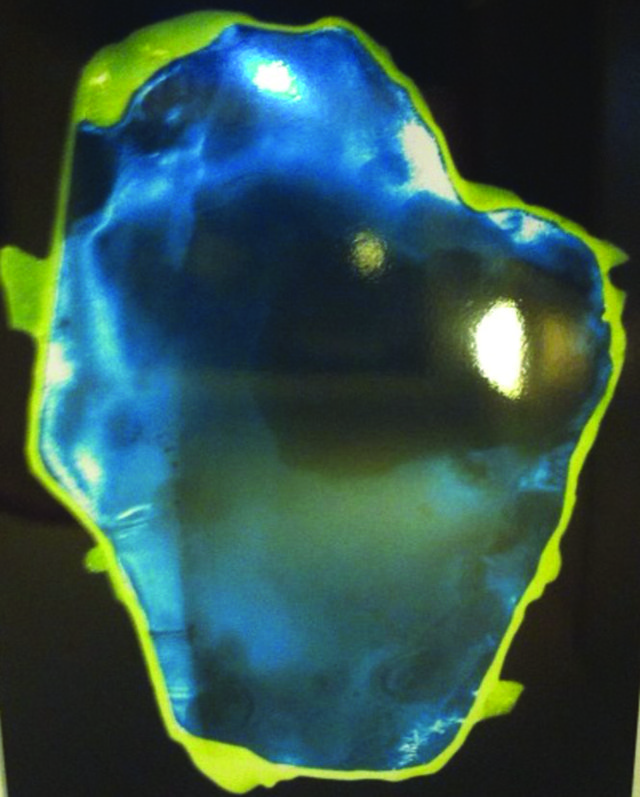
Lunar grain: the implantation of solar atoms has created an amorphous zone surrounding the grain (in yellow – false colour). Scale: 2×2 μm
‘My work is based on one analytical tool: the variations of stable isotope ratios of the volatile elements in natural environments – that is the fields of geochemistry and cosmochemistry’
The Origin of Water on Earth
Water is one of the primary components that led to the emergence of life on Earth. However, there is no simple response to the question of where the water on Earth came from. There are three main potential sources of water on the Earth: comets, meteorites and the protosolar molecular hydrogen embedded deep in the Earth during its formation. Dr Robert and his colleagues started by analysing the isotopic variation of hydrogen in a meteorite sample. Hydrogen exists in two stable isotopes – hydrogen and deuterium. Hydrogen atoms contain just a single proton in their nucleus, while atoms of deuterium also possess a neutron. Dr Robert measured significant variations in the abundance of the two isotopes across the meteorite sample, and found multiple sub-micrometric areas that were rich in deuterium. Such an observation could not be recreated by any laboratory experiment or under natural terrestrial conditions. Following this discovery, he found that clusters of Insoluble Organic Matter (hereafter IOM) were the primary source of these deuterium-rich regions. In addition to IOM, meteorites contained ice yielding clay minerals during a high temperature episode of liquid water circulation in meteorite parent bodies. Dr Robert quantified the deuterium content in water that had been circulated in meteorites, and found this to be closely related to terrestrial seawater.
When passing in close vicinity of the Sun, the ice surface of a comet vaporises, and scientists can measure the isotopic composition of this gaseous water. Such measurements have shown that, with few exceptions, the deuterium composition in water from a comet’s tail is much higher than that measured for meteorites or terrestrial water. In contrast, the isotopic composition of hydrogen in the Sun (which is implanted in the Lunar soils by the solar wind), is much lower than that measured for meteorites or terrestrial water.
Therefore, several conclusions on the origin of water on Earth can start to be made from the observations made by Dr Robert and his colleagues on the deuterium concentration in comets, meteorites and terrestrial seawater. Firstly, comets are likely to have had a negligible contribution (less than 10%) to water on Earth. Secondly, the possible occurrence of the protosolar molecular hydrogen deep in the Earth is negligible in the Earth’s water budget. Thirdly, most water on Earth probably came from the early addition of water-rich meteorites, present among the accreting bodies that formed the Earth. This last point currently remains a robust constraint in planetary formation models.
To understand the origin of the enrichment in deuterium in meteorite water, Dr Robert proposed that an isotope exchange reaction took place between the protosolar molecular hydrogen gas and the deuteriumrich interstellar water ice vaporised in the protosolar gas. He and his colleagues further confirmed this proposition by measuring the rates of this exchange in laboratory experiments, and by developing a 2D theoretical model of the protosolar disk, which highlighted a gradient of deuterium content between the deuterium-depleted centre to the deuterium-rich edges. Data on comets shows, with limited exceptions, that this result is qualitatively correct.
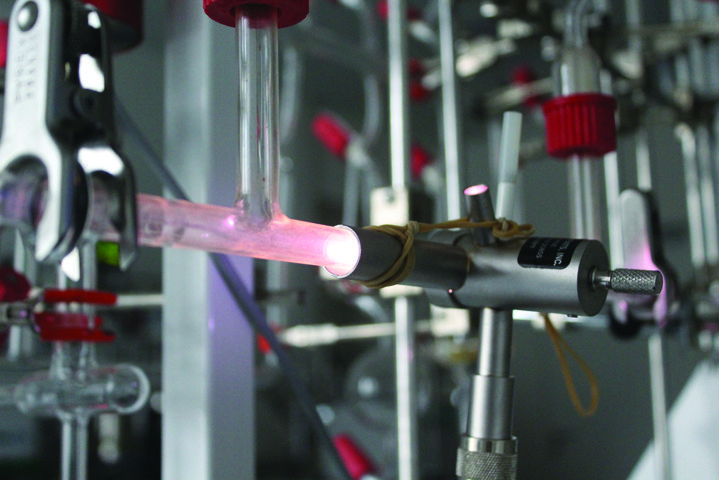
Methane plasma
Growing Organic Compounds in Meteorites
There are several theories behind the origin of IOM in meteorites. One theory posits that this matter was created through gas/grain reactions at −200°C in interstellar space, while another proposes that it was formed from a carbon rich gas under intense UV fluxes within the centre of the protosolar disk. Dr Robert and his team recently demonstrated, through experimental deposition in a plasma of methane, that the latter explanation was indeed compatible with the origin of IOM in meteorites. The organic deposition of methane using microwave-assisted technology was shown to produce similar hydrogen isotopic anomalies as those observed in meteorites. Thus, the team concluded that methane breaks up into CHX· radicals, which propagate reactions that lead to IOM formation in meteorites.
Several analytical approaches have shown that IOM in meteorites is enriched in deuterium compared with water. Dr Robert realised that in order to explain the origin of this, the structure of the IOM must first be resolved. He devoted a decade of research to elucidating the structure of the organic matter in meteorites. His team found that the structure comprised aromatic and aliphatic molecules and chemical linkages, including sulphide bridges (-S-), ester (-O-) and carboxylate (-O=C-O-) groups. ‘We discovered that, at a molecular level, the internal isotopic compositions of the IOM (i.e. between aliphatic, aromatic and benzylic bounds) is also in an opposite distribution compared with thermodynamical predictions,’ explains François Robert. A possible solution to this issue is the aforementioned condensation of radicals in plasma, for which the isotopic compositions of organic matter is not dictated by statistical situations.

Nuclear Reactions in the Solar System
During the formation of a new star, high energy hydrogen atoms are generated. When these hydrogen atoms subsequently react with nearby solid species, a series of nuclear events called spallation reactions can become initiated. Spallation reactions result in new elements being created through the break-up of heavier elements. Using an analytical instrument called a secondary ion mass spectrometer (SIMS), scientists can determine the isotopic composition of each element in a sample with sub-micrometric spatial resolution. The method works by separating fragmented and charged ions, according to their mass and charge.
Dr Robert and his colleagues used SIMS to analyse the isotopic compositions of lithium and boron in meteorites. The unstable beryllium 10 isotope (10Be) – containing four protons and six neutrons – is known to only be observed following a high-energy spallation reaction as it rapidly decays into the stable boron isotope 10B – containing five protons and five neutrons. The team discovered an excess in the concentration of 10B in a refractory mineral of a meteorite and showed that this high concentration is due to the decay of 10Be. Therefore, spallation reactions were occurring in the close vicinity of our Sun during its formation.
Studying the isotopic composition of lunar soils can also shed light on the mechanisms behind element creation. Strong solar magnetic winds result in the expulsion of atoms that are implanted into lunar soils. Dr Robert and his colleagues reported a comparative analysis of nitrogen and lithium isotopic compositions within lunar soils and terrestrial materials. Nitrogen exists has two isotopes: 14N and 15N. After the team analysed the lunar soil and meteorite grains, they found that meteorites and planetary atmospheres are surprisingly much richer in 15N than the Sun. The chemical or physical processes at the origin of this isotopic segregation of the volatile elements between the gas (presumably reflected by the Sun) and the solids (presumably reflected by meteorites and planetary atmosphere) remains enigmatic since that time.

CREDIT: CNRS/MNHN – M. Bronchy (2014)
Creating Extra-terrestrial Reactions in a Laboratory
Chemical reactions in both interstellar space and within protosolar disks occur under extreme conditions. The ability to recreate such conditions within a laboratory, whilst remaining within acceptable health and safety standards, is no simple task!
Along with his colleagues, Dr Robert conducted a series of high temperature reactions of gaseous Ca-Mg-Si-O mixtures to quantitatively demonstrate the experimental conditions required for the mineral condensation from a solar composition.
Meteorites have a consistent but unique isotopic signature of oxygen. Since 1983, it is known that the synthesis of ozone (O3) within the laboratory, yields a near identical isotopic signature. However, no consensus has emerged to account for this isotopic distribution. Dr Robert conducted a series of calculations on the isotope distribution of oxygen during ozone formation. ‘We have proposed a possible origin for this effect which would be ultimately caused by the property of indistinguishable isotopes involved in collisional processes,’ he explains. This signature is the most puzzling scientific problem raised by solar system materials.
Proposing Archean Sea Temperatures
Cherts are terrestrial sedimentary rocks made of almost pure silica, which cover the whole Precambrian era and date between 3.5 to 0.5 billion years old. Their oxygen and silicon isotope composition is believed to reflect the composition in the moments following their precipitation from seawater, and can therefore be used to figure out what the temperature of seawater was during the Archean and Precambrian time periods. Dr Robert and his colleagues measured these isotope compositions and developed a geochemical model to reconstruct seawater temperatures. Using this method, they propose that over the last 3500 million years, the temperature of seawater decreased from approximately 50°C to the present day mean value (about 10°C).
In addition to reconstructing the temperature variations of ancient oceans, the team also use the nitrogen isotopic compositions of organic matter in Cherts to identify the metabolic pathways of some ancient microorganisms that are fossilised within these siliceous rocks.
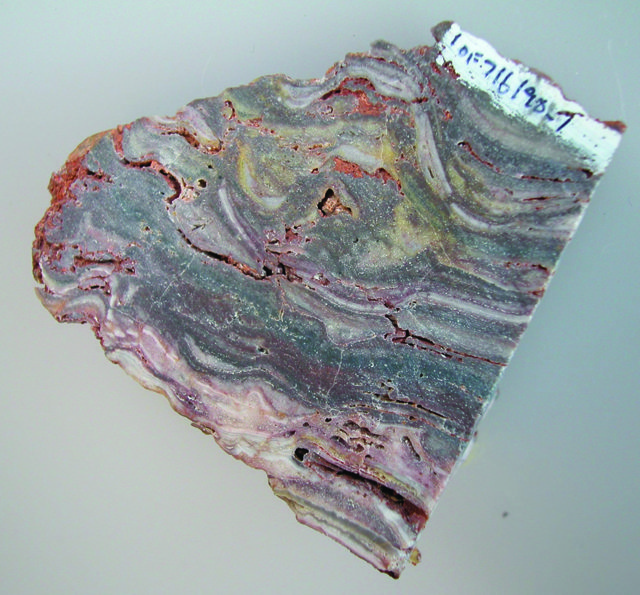
3.5-billion-year-old stromatolitic Chert – Sample from J.W. Schopf
Weighing up Comet Fragments
Following a mission into space, material from a comet was brought back to Earth, and Dr Robert was given the opportunity by NASA to analyse its chemical composition. The National Museum of Natural History installed a NanoSIMS instrument, which is similar to a SIMS instrument but has a better spatial resolution. When measuring the isotopic distribution within a sample, surface areas of 1 square micrometre can be analysed, giving a unique and detailed chemical resolution of isotope distribution.
Using the NanoSIMS instrument, Dr Robert showed the chemical similarities and differences between inner (meteorites) and outer (comets) solar system material. The isotopic distribution within the cometary grains showed that some of them formed in close vicinity to the Sun, and were then transported to the edge of the protosolar disk. Condensation processes under lower temperature conditions at the edge of the disk would have caused the cooler grains to condense and form the comet.
Future Directions
Dr Robert intends to continue his work combining both experimental and theoretical approaches to predict the origin of isotopic distribution in solar system materials. He argues that ‘a currently unrecognised physical process may be the origin of a common property that governs the isotopic variations in solar system matter’.
Meet the researcher

Dr François Robert
Institut de minéralogie, de physique des matériaux
et de cosmochimie (IMPMC) – UMR 7590
National Museum of Natural History
Paris
France
Dr François Robert achieved his PhD in the field of cosmochemistry in 1982 at the Institut de Physique du Globe (IPG-P) France. Between 1983 and 1990, he undertook positions at the French Atomic Energy Commission (CEA) at Saclay, at Caltech, USA, and at the National Center for Scientific Research (CNRS), France. Dr Robert then became ‘Director of Research’ at the CNRS within the Laboratory of Stable Isotope Geochemistry (IPG-P). He moved to the Laboratoire de Minéralogie at the Museum National Histoire Naturelle (MNHN) in 1992. Between 2003 and 2015, Dr Robert was the Director of a new laboratory at the Museum, devoted to Cosmochemistry. He is a prominent researcher in his field, with research focuses including applications of stable isotopes in cosmochemistry, planetology and geochemistry, resolving the origin of water and organic molecules in the solar system and using both experimental and theoretical methods to study isotopic fractionation. Dr Robert is also the recipient of multiple prestigious awards, including the Leonard Medal in 2011 from the Meteoritical Society, for which Professor Robert was made a Fellow of in 2002, and also the CNRS Silver Medal.
CONTACT
E: robert@mnhn.fr
T: (+33) 6 30 06 16 07
W : http://www.impmc.upmc.fr/fr/equipes/cosmochimie_cosmo/liste_ des_membres/membres_permanents/francois_robert.html
KEY COLLABORATORS
Madeleine Selo, MNHN, Paris, France
Marc Chaussidon, IPG-P, Paris, France
Sylvie Derenne, UPMC, Paris, France
Bernard Marty, CRPG, Nancy, France
Guy Libourel, OCA, Nice, France
Peter Reinhardt, UPMC, Paris, France
Adriana Gonzalez, Remi Duhamel,
Smail Mostefaoui, MNHN, Paris, France
FUNDING
PNP Programme National de Planétologie (CNRS-INSU)
CNES (Centre National Etudes Spatiales – Exobiologie)
ANR (Agence National de la Recherche)
ERC (European Research Grant)
REFERENCES
S Derenne and F Robert, Model of molecular structure of the Insoluble Organic Matter isolated from Murchison meteorite, Meteoritics and Planetary Sciences, 2010, 45, 1461–1475.
F Robert and M Chaussidon, A paleotemperature curve for the Precambrian oceans based on silicon isotopes in cherts, Nature, 2006, 443, 969–973.
F Robert, The origin of water on Earth, Science, 2001, 293, 1056–1058.
V Beaumont and F Robert, Nitrogen isotope ratios of kerogens in Precambrian cherts: A record for the evolution of atmosphere chemistry?, Precambrian Research, 1999, 96, 63–82.
F Robert and S Epstein, The concentration and isotopic compositions of hydrogen, carbon and nitrogen in carbonaceous chondrites, Geochimica et Cosmochimica Acta, 1982, 16, 81–95.

